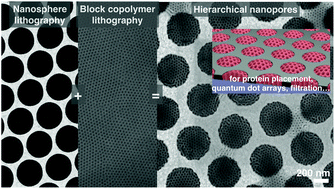Our official English website, www.x-mol.net, welcomes your
feedback! (Note: you will need to create a separate account there.)
Hierarchical nanopores formed by block copolymer lithography on the surfaces of different materials pre-patterned by nanosphere lithography†
Nanoscale ( IF 5.8 ) Pub Date : 2018-04-25 00:00:00 , DOI: 10.1039/c8nr01397g Katharina Brassat 1, 2, 3, 4, 5 , Daniel Kool 1, 2, 3, 4, 5 , Julius Bürger 1, 2, 3, 4, 5 , Jörg K. N. Lindner 1, 2, 3, 4, 5
Nanoscale ( IF 5.8 ) Pub Date : 2018-04-25 00:00:00 , DOI: 10.1039/c8nr01397g Katharina Brassat 1, 2, 3, 4, 5 , Daniel Kool 1, 2, 3, 4, 5 , Julius Bürger 1, 2, 3, 4, 5 , Jörg K. N. Lindner 1, 2, 3, 4, 5
Affiliation

|
Bottom-up patterning techniques allow for the creation of surfaces with ordered arrays of nanoscale features on large areas. Two bottom-up techniques suitable for the formation of regular nanopatterns on different length scales are nanosphere lithography (NSL) and block copolymer (BCP) lithography. In this paper it is shown that NSL and BCP lithography can be combined to easily design hierarchically nanopatterned surfaces of different materials. Nanosphere lithography is used for the pre-patterning of surfaces with antidots, i.e. hexagonally arranged cylindrical holes in thin films of Au, Pt and TiO2 on SiO2, providing a periodic chemical and topographical contrast on the surface suitable for templating in subsequent BCP lithography. PS-b-PMMA BCP is used in the second self-assembly step to form hexagonally arranged nanopores with sub-20 nm diameter within the antidots upon microphase separation. To achieve this the microphase separation of BCP on planar surfaces is studied, too, and it is demonstrated for the first time that vertical BCP nanopores can be formed on TiO2, Au and Pt films without using any neutralization layers. To explain this the influence of surface energy, polarity and roughness on the microphase separation is investigated and discussed along with the wetting state of BCP on NSL-pre-patterned surfaces. The presented novel route for the creation of advanced hierarchical nanopatterns is easily applicable on large-area surfaces of different materials. This flexibility makes it suitable for a broad range of applications, from the morphological design of biocompatible surfaces for life science to complex pre-patterns for nanoparticle placement in semiconductor technology.
中文翻译:

通过嵌段共聚物光刻在纳米球光刻预先构图的不同材料的表面上形成的分层纳米孔†
自下而上的图案化技术允许在大面积上创建具有纳米尺度特征的有序阵列的表面。两种适用于在不同长度尺度上形成规则纳米图案的自下而上的技术是纳米球光刻(NSL)和嵌段共聚物(BCP)光刻。本文表明,可以将NSL和BCP光刻技术结合起来轻松地设计不同材料的分层纳米图案化表面。纳米球光刻技术用于对带有解毒剂的表面进行预图案化,即在SiO 2上的Au,Pt和TiO 2薄膜中以六角形排列的圆柱孔,可在表面上提供周期性的化学和形貌对比,适合在随后的BCP光刻中进行模板化。PS- b-PMMA BCP在第二个自组装步骤中使用,以在微相分离后在解毒剂内形成直径小于20 nm的六角形排列的纳米孔。为此,还研究了平面上BCP的微相分离,并首次证明了可以在TiO 2上形成垂直BCP纳米孔。,Au和Pt膜而无需使用任何中和层。为了解释这一点,研究和讨论了表面能,极性和粗糙度对微相分离的影响,以及BCP在NSL预图案化表面上的润湿状态。提出的用于创建高级分层纳米图案的新颖途径很容易适用于不同材料的大面积表面。这种灵活性使其适用于广泛的应用,从用于生命科学的生物相容性表面的形态设计到用于半导体技术中纳米粒子放置的复杂预图案。
更新日期:2018-04-25
中文翻译:

通过嵌段共聚物光刻在纳米球光刻预先构图的不同材料的表面上形成的分层纳米孔†
自下而上的图案化技术允许在大面积上创建具有纳米尺度特征的有序阵列的表面。两种适用于在不同长度尺度上形成规则纳米图案的自下而上的技术是纳米球光刻(NSL)和嵌段共聚物(BCP)光刻。本文表明,可以将NSL和BCP光刻技术结合起来轻松地设计不同材料的分层纳米图案化表面。纳米球光刻技术用于对带有解毒剂的表面进行预图案化,即在SiO 2上的Au,Pt和TiO 2薄膜中以六角形排列的圆柱孔,可在表面上提供周期性的化学和形貌对比,适合在随后的BCP光刻中进行模板化。PS- b-PMMA BCP在第二个自组装步骤中使用,以在微相分离后在解毒剂内形成直径小于20 nm的六角形排列的纳米孔。为此,还研究了平面上BCP的微相分离,并首次证明了可以在TiO 2上形成垂直BCP纳米孔。,Au和Pt膜而无需使用任何中和层。为了解释这一点,研究和讨论了表面能,极性和粗糙度对微相分离的影响,以及BCP在NSL预图案化表面上的润湿状态。提出的用于创建高级分层纳米图案的新颖途径很容易适用于不同材料的大面积表面。这种灵活性使其适用于广泛的应用,从用于生命科学的生物相容性表面的形态设计到用于半导体技术中纳米粒子放置的复杂预图案。











































 京公网安备 11010802027423号
京公网安备 11010802027423号